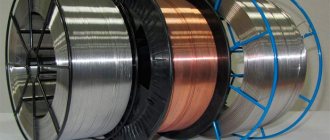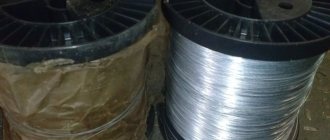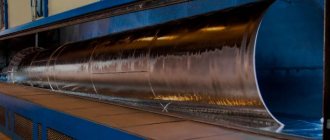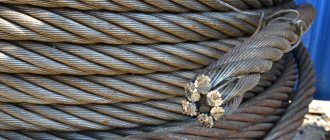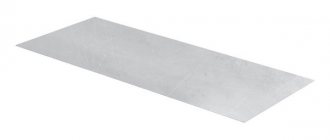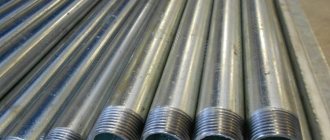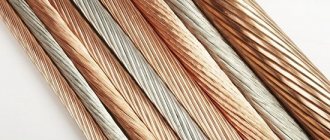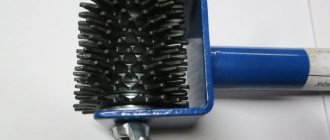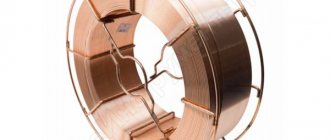Main types
There are two main types of barbed wire. Let's take a closer look at them.
Galvanized
Despite all the external similarities, modern barbed wire is not exactly the same as what was patented at the end of the 19th century. To date, about 450 patents have already been issued for it. Collectors of wire fences (it turns out there are such people) count up to 2 thousand different types and samples. Manufacturers' catalogs often mention only 2 dozen main varieties. The simplest option is a single-base corrugated design with spikes throughout.
The thickness of such a product is most often 2.8 mm. This is the option that is usually used in summer cottages and fences around private houses.
Reinforced
Coating with a protective layer of zinc does not always help solve the problems. Sometimes more significant strengthening of the enclosing structure is required. The following options are known:
- Bruno spiral (coils of different diameters);
- flat corrugated tape with a pointed edge;
- “chain-link” with diamond-shaped cells;
- spikes that complement the main fence.
A biaxial (more precisely, two-basic) barbed barrier is also in demand. For the most part, it is made of galvanized metal.
A typical barbed wire texture looks like this.
Products operating under voltage must be designed for a current of 2-10 kV. They are mainly produced for livestock farming and penitentiary use. Returning to tape structures, it is worth pointing out that they can damage significant areas of soft tissue. They are used to protect structures, including those built on frames and supports. And the classic type of barbed wire is used mainly in independent execution.
The traditional version is often called “thread”. This is always galvanized material with a thickness of 2.5 to 2.8 mm. Exceeding these limits is strictly not recommended. There are threads made from one wire or from two strands, braided into a “pigtail”. The same distinction is made between spikes. Stamped spikes are used mainly where the maximum degree of security is needed.
The elastic “thread” is relatively strong and has a small cross-section. This material is more resistant to the negative effects of temperature changes. Resistance to mechanical stress is also increased. As a result, “threads” with increased elasticity are used for the construction of large spans. As for the “soft” wire, it is much more convenient when fastening.
However, over time, such a fence weakens and begins to sag intensively. This drawback is especially pronounced with significant spans. The problem is not too significant if you install the wire in small areas. In addition, technologists classify piercing and cutting tape and reinforced “twist” into a special category. Experts consider everything else to be only subspecies of the three main types of barbed wire.
Advantages and disadvantages of installing Egoza on a fence
Installing Egoza on a fence is a great way to protect your territory from intruders. Dismantling a correctly and securely fastened “thorn” requires serious time investment.
In addition, the following advantages of installing a barrier structure on a fence are highlighted.
- Possibility to make an energized fence. This will significantly increase security.
- Reliability. "Egoza" is resistant to corrosion. The service life of the “thorn” manufactured in accordance with GOST is more than 25 years.
- Availability. Anyone can afford to buy a spiral or flat safety barrier.
- Easy to install. Installing Egoza on the fence is quick.
- A large number of installation options and application purposes. For example, for additional protection of the territory and fencing from animals and intruders, you can stretch the Egoza along the ground on one or both sides of the fence.
The disadvantages of installing Egoza include only deterioration in the appearance of the fences.
Installation rules
Vertical supports dug into the ground are fastened in increments of no more than 3 m. These supports are quite sufficient for installing the wire itself; nothing else is required. But increasing the degree of security is only possible with additional tension on the wire in the transverse plane relative to the main strip. Barbed thread can be used in addition to already created protective structures. In this case, it is mounted on top of fences and gates.
Reinforced tape is much more difficult to install. To install it you will need:
- scissors for cutting metal reinforcement;
- Grinder;
- some other tools, which depends on the method of fastening the wire at the support points.
Installation of Egoza wire will be simplified when using special brackets. For flat and spiral models, you can use the same type of brackets. They can be installed in a variety of places. Now they sell brackets in different formats:
- direct;
- L-shaped;
- Y-shaped.
You should prepare the fence yourself with a step between brackets of no more than 2.5-3 m. You need to work not only in protective gloves, but also in thick clothing. Sometimes it makes sense to even wear safety glasses. The shape of the bracket is selected taking into account ease of installation. Before starting work, the area should be marked.
The reference points are fixed using bolts or welding. Then a spiral is mounted on top of the brackets using special brackets. The next step is to stretch the double string along the entire length of the spiral. The spiral itself is aligned, and it is secured using twists of a special pattern.
Finally, the individual parts of the wire fencing are connected using mounting brackets. If the fence is energized, you must warn about this by hanging special signs around the perimeter with clear warning text.
Watch the video below about the production of barbed wire.
Precautionary measures
Barbed wire in any version is a rather dangerous material when installed. Barbed strip and combined rolled wire with a core are especially dangerous - they not only tear, but also cut human skin. Therefore, it is necessary to work in appropriate protective clothing:
- thick fingerless mittens (so that no wire gets between them);
- thick multi-layer clothing - jacket, pants, overalls;
- wearing clear glasses to protect the eyes;
- in shoes with thick and hard soles.
Take special care when working with elastic wire - if bent, it can straighten out and whip you in the face or body.
History of creation
It is impossible to name just one name of the person who invented the barbed defense. But it is quite obvious that the weak restraining ability of ordinary flat wire prompted its creation. It can hardly be considered as a serious barrier for animals on pastures or for criminals in prisons. In 1872, the American farmer G. Rose came up with the idea of attaching boards with sharpened wires to a simple wire fence. The patent was received approximately six months later.
But the modern look of barbed wire was created by Joseph Glidden. He realized that attaching sharp elements to boards was irrational, so he created a metal structure, which without additional devices became a serious obstacle. Wrapping them with metal wire without points helped prevent the spikes from moving.
Important: Glidden did not create his design from scratch, but was based on samples already known at that time, including those proposed in France
Barbed wire also owes a lot to J. Gates. For the first time in the United States, he widely used advanced metal smelting methods, which made it possible to reduce production costs. It was also Gates who carried out an advertising campaign showing that dozens of cows were securely held by a wire fence. Reducing the price of the finished product and bright marketing did their job - soon the “thorn” was bought not only by those who were looking for an effective replacement for a wooden fence around their home. They began to use it in places where the abundance of forests made it possible to build traditional pens, because it turned out to be simpler and more profitable.
Types and applications of steel wire
As you can see, depending on the production method, the use of protective coating, as well as thickness, weight and density, different types of steel wire are produced.
When we talked about the manufacturing process, we mentioned that the finished product is fired. In this case, the output is a flexible product that can be used for knitting, for example, chain-link mesh, bending reinforcement, supports for trees or plants, and so on.
Such wire is usually galvanized due to the nature of its operation - outdoors, with frequent direct exposure to water, high and low temperatures.
- For Chainlink, heat-treated, zinc-coated wire with a diameter of 1.30 to 6.30 mm is used.
- For grape supports, flexible low-carbon steel wire with a rather small nominal cross-section is also used - 2.10-2.30 mm.
- For communication lines, only galvanized steel wire must be used, while the core itself is made of special “T” type steel.
Therefore, both thin and thick wire products are widely used. For some types of fittings it is also important to use rigid, unburnt wire.
And, in conclusion, we can say that we have proven what was said at the beginning: low-carbon steel wire is a truly universal material that is widely used to make completely different products that find their application in many areas of life.
Fencing
You can install barbed wire on:
- Pillars. It is enough to secure them well, stretch a “thorn” of a suitable type between them;
- An ordinary fence (fence). It is installed on top, mounted on special brackets (gitter mesh). Usually such a fence is made of stone, quite massive and high, and the barbed wire itself is laid in the form of a spiral.
Photo of barbed wire
Vaira Metal mesh Wire Fences and Fidget
- Rabitz
- Lightweight Cossack mesh
- Uzelfix mesh
- Welded mesh
- Masonry mesh for reinforcement from wire VR-1 (armopoyas)
- Cossack masonry mesh
- Expanded mesh
- Woven mesh GOST 3826-82
- Corrugated mesh
- Channeled mesh
- Twisted hexagonal mesh
- Stainless filter mesh
- Brass mesh L-80
- Conveyor woven mesh
- Conveyor woven mesh
- Hinged mesh
- Reinforcing façade fiberglass mesh
- Tensioner for mesh and wire
- Low carbon wire GOST 3282-74
- Egoza
- Metal fences
- Construction nails
- Perforated sheet
- Gabions
Steel fiber
- Lawn mesh
News
Installation of the “thorn”
To protect your dacha, there are 2 options for installing a protective fence:
- On top of or on a regular fence;
- Make a continuous spiked (barbed) fence.
For this we need:
- Barbed wire (preferably reinforced);
- Mounting brackets;
- Electric welding machine;
- Electrodes;
- Hardware (staples);
- Pliers;
- String;
- Protective clothing;
- Mittens.
The brackets are welded to the posts. The barbed wire is stretched and secured with hardware. To prevent it from sagging, the string is stretched. A “thorn” is evenly distributed and secured on top of it.
To make a continuous fence made of barbed wire (which can often be seen in the photo), pillars are dug in at a distance of at least 2 meters from each other. To increase stability, it is better to concrete them or make supports.
To tighten and fix the “thorns”, “eyes” are welded to the posts along the entire length. Their pitch is at least 100 mm. The barbed wire is secured to the “eyes” using hardware (staples).
To increase the protective functions of the fence, voltage can be applied to it. At the same time, you must remember to post a sign warning about this!
Lifehack
Supplying high frequency currents to the wire can cause more trouble to the owner than it is worth.
However, there is another option - to close the low-current network through a wire fence and connect it to a simple security system sensor.
When the wire is cut or bitten, the contact opens and an alarm is triggered, sending information to the owner or security post. At the same time, exposure to low current is completely safe.
Barbed wire is an indispensable option when it is necessary to fence off a large area allocated for agriculture - gardening, vegetable farming, livestock farming.
In combination with existing fences, barbed wire will greatly increase the effectiveness of preventing entry into the house.
Varieties
According to the manufacturing method, the “thorn” is divided into:
Galvanized steel wire with spikes along its entire length. Its thickness is 2.8 mm. It is the simplest protective structure for protecting your property on a farm or country house;
Reinforced (corrugated) tape. It looks like a thin strip of steel with razor-sharp edges. It has 2 varieties - AKL (straight) and ASKL (twisted).
Domestic manufacturers produce various versions of the “thorn” for all household, industrial, strategic and other needs. The most popular and well-known products are under two brands:
- "Egoza";
- "Gyurza."
Design features, application
A thin strip (metal thread) with spikes along its entire length - this is the design of barbed wire. Simple and unpretentious. But very effective!
France is considered the birthplace of the “thorn”, although it gained fame in America thanks to one farmer named Henry. He used it as a fence, which interested the others.
The barbed wire fence was reliable, had high protective properties at a fairly low price. This interested many farmers. There was “mad demand” for such fencing.
The first company that seriously began selling “thorns” was able to sell 270 tons of them!
A lot of time has passed since then. Razor fencing is still in demand and is used to protect:
- Private property (territory);
- Military bases;
- Special sports grounds;
- Strategically important objects;
- Enterprises;
- Facilities launched into construction;
- Areas where special dog training takes place;
- Various prison colonies;
- Various private pastures.
Types and scope of application
Galvanized wire products can be made from a variety of materials. A steel, aluminum, titanium base is used. In some cases, manufacturers give preference to nickel, zinc, and copper. Suitable alloys are bimetallic or polymetallic.
Thanks to this, the wire has improved qualities and excellent corrosion resistance. It is sold to customers in special skeins of 20-200 kg. Coils of 0.8-1.2 tons are also used.
Galvanized wire is produced using thermal treatment technology or without the use of this method.
The methods of processing the material also differ - soft knitting treatment, thermal or hard treatment without treatment.
If the wire is subjected to thermal hardware action, then it can be used in the manufacture of nails with a diameter of 1-6 mm, chain-link mesh, and in the process of aerial cable fastening. Taking these factors into account, the price of galvanized wire is determined.
The semi-finished product is used in the production of household items - handles for buckets, hangers for hanging clothes, fasteners for drawers.
Sometimes the scope of application expands, and therefore it can be found in the process of reinforcing preparation of power transmission wires. It is used not only for installing cable products, but also for creating staples, key rings, and paper clips.
The material is used in the manufacture of mesh, and also as an element of security systems; in particular, galvanized barbed wire is popular.
There are several other areas of application:
- In welding works.
- For laying communication channels - it has normalized electrical resistance and low elongation. The material is type T steel. Diameter is 1.5-4 mm. The disadvantage is the risk of sagging as a result of heating. The coil of wire is covered with paper with an impermeable effect and a cloth containing chemical fibers.
- In the production of cores that are used in aluminum and steel wires without insulation. Grades for stranded and single-wire cores are used, belonging to types A, B and C, depending on the mechanical properties.
How to properly install Egoza on a fence (useful tips)
Correctly installing the Egoza on the fence is half the battle; it is also important not to get hurt during the work. Therefore, safety precautions should be observed.
- Installation must be carried out in thick protective clothing, as you can seriously cut yourself. Particular care should be taken to protect your hands and wrists. Thick gauntlets designed for welding work are best.
- The support (stepladder or sawhorse) should be as reliable as possible. If you fall from it directly onto the wire, there is a high risk of serious injury.
- If possible, use the help of one or two partners.
- When installing a protective barrier on a metal fence, the brackets can be welded to the posts. It will be more reliable this way.
Peculiarities
Egoza barbed wire is a type of security fencing produced by the brand of the same name. The Chelyabinsk plant where it is produced is part of the group. Among his clients are government agencies, nuclear, thermal, electric power facilities, the Ministry of Internal Affairs and the Armed Forces of the Russian Federation. When developing wire, specialists from the Egoza perimeter fencing plant take into account the level of responsibility when protecting objects of special importance and the needs of ordinary citizens who want to ensure reliable protection of their areas.
Flat belt structures have more varied technical characteristics. Thus, for Egoza products, a spiral with a five-rivet fastening of the AKL type, the mass of the coil, depending on its diameter, ranges from 4 to 10 kg. The weight of 1 meter is easy to calculate based on the length of the skein - normally it is 15 m.
The manufacturer produces several types of Egoza brand wire. All products have common features: made from steel or galvanized tape, the presence of sharp spikes. All varieties are highly durable and reliable, have a long service life, and can be mounted either around the perimeter of existing fences or independently, supported on poles.
The main purpose of Egoza wire is to protect objects from unauthorized entry. In livestock grazing areas, it is used to prevent or stop the movement of the animal outside the designated area. In industrial, military, secret, protected facilities, in water and environmental protection zones, in places with limited access, barbed wire acts as a protective barrier, allowing it not to block visibility and access to natural light, as is the case with solid fences.
Depending on the type of product, its installation can be carried out in different ways. Most often this wire is used for:
- creating fences around the perimeter of the roofs;
- fixation on vertical posts (several levels);
- installations on supports with a horizontal tension string for 10–15 sections;
- laying on the ground (quick deployment).
All these features make barbed wire a popular solution for use on various types of objects.
